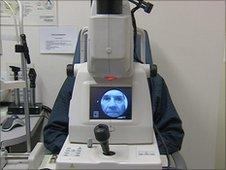Sight loss could double by 2031
- Published

The RNIB advised people to get their eyes tested every two years
The number of Scots who are blind or partially sighted could double in the next 20 years, according to a report by RNIB Scotland.
The report predicted that 400,000 people could be affected by 2031, due to problems associated with an ageing population.
The charity's Scottish director called for more to be spent on prevention.
John Legg also said he wanted to raise awareness of the dangers of diabetes and smoking to eyesight.
New spectacles
The Royal National Institute of Blind People (RNIB) said that almost two million people in the UK were living with sight loss.
It suggested that for more than half of these a simple sight test and new spectacles could help.
Mr Legg, speaking at the start of National Eye Health Week, said that a 62% increase in the elderly population by 2031 meant it was important that provision was made now to cover the cost.
The report highlighted the dangers of smoking and diabetes.
RNIB research found that diabetes affected almost 5% of the Scottish population.
The report's authors said diabetic retinopathy was one of the most serious and costly complications of diabetes and the leading cause of blindness among the working-age population in the UK.
"Someone with diabetes has a 10 to 20 times greater chance of being registered blind," Mr Legg said.
"However, early diagnosis and treatment can prevent up to 98% of severe sight loss and the earlier the treatment the more likely it is to be effective.
The report also pointed to claims that for every 1,000 smokers who quit there would be an estimated 12 fewer cases of blindness.
The RNIB advised people to get their eyes tested every two years.
Mr Legg said: "If a new virus was discovered that threatened to cause sight loss in 3,000 adults a year in Scotland it would receive the highest of priorities.
"Yet because this problem has been with us since the inception of the NHS it has become just part of the accepted background."
- Published11 June 2010
- Published8 June 2010